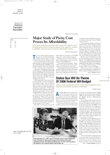Just as the World Wide Web has become an online tool for graphics and video, it was an inevitable evolution that the telephone would merge with the computer through the ubiquitous network called the Internet. A phenomenon called voice over Internet protocol (VoIP) has been changing the way we think about using the phone, particularly long-distance calls.
The basic premise of the Internet is that geographic boundaries are virtually eliminated and that individuals or groups can connect seamlessly at any time. VoIP is a method for taking analog audio signals and turning them into digital data that can be transmitted over the Internet. This process is similar to turning an audio CD into an mp3 music file. VoIP converts the voice signal, for example, from your telephone into a digital signal that travels over the Internet, then converts it back at the other end so you can speak to anyone with a regular phone number.
To use VoIP, a broadband or high-speed Internet connection is required. This can be a cable modem or other high-speed service such as DSL or a local area network. There is a number of ways to make a call: you can connect an inexpensive microphone to your computer, connect a phone to an adaptor called an analog telephone adaptor (ATA), or get a specialized IP (Internet protocol) phone, which connects directly to a router. The next generation of VoIP phones will be WiFi, which will allow subscribers to make wireless calls from any WiFi network.
Software that converts the analog signals to digital information is generally provided with the hardware or can be downloaded from the Internet. Installation is generally uncomplicated. In VoIP phones, the software is built into the circuitry. When placing a VoIP call using a phone with an adapter, you hear a dial tone and dial just as you always have.
Existing phone systems utilize a very reliable but somewhat inefficient method for connecting calls called circuit switching. Circuit switching has been the standard for more than 100 years. In the case of a call involving two parties, the two points are connected for the duration of the call in both directions, and the connection is called a circuit. This is the foundation of the Public Switched Telephone Network (PSTN).
Data networks do not use circuit switching. Internet connections do not maintain a constant connection to the Web page being viewed. Instead, data networks send and retrieve data as needed, and instead of the data's being routed over a dedicated line, the data packets flow through the Internet along thousands of possible paths. This is called packet switching. So while circuit switching keeps the connection open and constant, packet switching opens a brief connection—just long enough to send a small chunk of data, called a packet, from one system to another.
As its name implies, a VoIP phone has not only a telephone number but also an IP address, just as any Internet-connected device does. Why is this important? It allows for flexibility previously unknown in traditional landline phones. With VoIP, you can make a call from anywhere you have broadband connectivity. Since the IP phones or ATAs broadcast their information over the Internet, they can be used anywhere there is a connection. Essentially, it allows you to take your home phone with you wherever you go.
Another alternative is the softphone. A softphone is client software that loads the VoIP service onto your desktop or laptop. The Vonage softphone has an interface on your screen that looks like a traditional telephone. As long as you have a headset/microphone, you can place calls from your laptop anywhere in the broadband-connected world.
The cheapest and easiest way to use VoIP is through computer-to-computer calls. These can be entirely free, and the software necessary can be downloaded free from the Internet. Only a headset with a microphone or a microphone and set of speakers and a good Internet connection are required.
Most VoIP companies are offering minute-rate plans structured like mobilephone plans for as little as $30 a month. On the higher end, some offer unlimited plans for $79. With the elimination of unregulated charges and the addition of a suite of free features included with these plans, the savings can be substantial.
Most VoIP companies provide the features for which phone companies charge extra when added to your service plan. VoIP generally includes these features: caller ID, call waiting, call transfer, repeat dial, return call, and three-way calling.
Some carriers offer advanced call-filtering options. These features use caller ID information to allow you to make a choice about how calls from a particular number are handled. For example, you can forward the call to a particular number, send the call directly to voicemail, give the caller a busy signal, play a “not-in-service” message, or send the caller to a funny rejection hotline.
With many VoIP services, you can also check voicemail via the Web or attach messages to an e-mail that is sent to your computer or handheld device. Prices and services vary, so if you're interested, it's best to do a little shopping.
A testament to the potential of this technology can be seen in the fact that most of the major telephone carriers are establishing VoIP calling plans for businesses as well as for consumers. The Forrester Research Group predicts that nearly 5 million U.S. households will have VoIP phone service by the end of 2006. Perhaps the biggest draws to switch to VoIP are price and flexibility.
